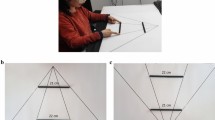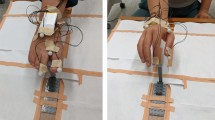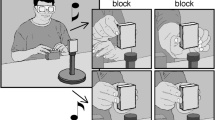Abstract
Action observation and execution share overlapping neural resonating mechanisms. In the present study, we sought to examine the effect of the activation of this system during concurrent movement observation and execution in a prehension task, when no a priori information about the requirements of grasping action was available. Although it is known that simultaneous activation by observation and execution influences motor performance, the importance of the delays of these two events and the specific effect of movement observation itself (and not the prediction of the to-be-observed movement) on action performance are poorly known. Fine-grained kinematic analysis of both the transport and grasp components of the movement should provide knowledge about the influence of movement observation on the precision and the performance of the executed movement. The experiment involved two real participants who were asked to grasp a different side of a single object that was composed of a large and a small part. In the first experiment, we measured how the transport component and the grasp component were affected by movement observation. We tested whether this influence was greater if the observed movement occurred just before the onset of movement (200 ms) or well before the onset of movement (1 s). In a second experiment, to reproduce the previous experiment and to verify the specificity of the grasping movements, we also included a condition consisting of pointing towards the object. Both experiments showed two main results. A general facilitation of the transport component was found when observing a simultaneous action, independent of its congruency. Moreover, a specific facilitation of the grasp component was present during the observation of a congruent action when movement execution and observation were nearly synchronised. While the general facilitation may arise from a competition between the two participants as they reached for the object, the specific facilitation of the grasp component seems to be directly related to mirror neuron system activity induced by action observation itself. Moreover, the time course of the events appears to be an essential factor for this modulation, implying the transitory activation of the mirror neuron system.



Similar content being viewed by others
References
Blakemore S-J, Frith C (2005) The role of motor contagion in the prediction of action. Neuropsychologia 43:260–267
Bouquet CA, Shipley TF, Capa RL, Marshall PJ (2011) Motor contagion: goal-directed actions are more contagious than non-goal-directed actions. Exp Psychol 58:71–78. doi:10.1027/1618-3169/a000069
Brass M, Bekkering H, Wohlschläger A, Prinz W (2000) Compatibility between observed and executed finger movements: comparing symbolic, spatial, and imitative cues. Brain Cogn 44:124–143
Brass M, Bekkering H, Prinz W (2001) Movement observation affects movement execution in a simple response task. Acta Psychol (Amst) 106:3–22
Buccino G, Binkofski F, Fink GR et al (2001) Action observation activates premotor and parietal areas in a somatotopic manner: an fMRI study. Eur J Neurosci 13:400–404
Castiello U, Lusher D, Mari M et al (2002) Observing a human or a robotic hand grasping an object: differential motor priming effects. Common mechanisms in perception and action. Atten Perform XIX:315–333
Catmur C, Mars RB, Rushworth MF, Heyes C (2011) Making mirrors: premotor cortex stimulation enhances mirror and counter-mirror motor facilitation. J Cogn Neurosci 23:2352–2362. doi:10.1162/jocn.2010.21590
Christensen A, Ilg W, Giese MA (2011) Spatiotemporal tuning of the facilitation of biological motion perception by concurrent motor execution. J Neurosci 31:3493–3499. doi:10.1523/JNEUROSCI.4277-10.2011
Craighero L, Bello A, Fadiga L, Rizzolatti G (2002) Hand action preparation influences the responses to hand pictures. Neuropsychologia 40:492–502
Di Pellegrino G, Fadiga L, Fogassi L et al (1992) Understanding motor events: a neurophysiological study. Exp Brain Res 91:176–180
Dijkerman HC, Smit MC (2007) Interference of grasping observation during prehension, a behavioural study. Exp Brain Res 176:387–396
Edwards MG, Humphreys GW, Castiello U (2003) Motor facilitation following action observation: a behavioural study in prehensile action. Brain Cogn 53:495–502
Fadiga L, Fogassi L, Pavesi G, Rizzolatti G (1995) Motor facilitation during action observation: a magnetic stimulation study. J Neurophysiol 73:2608–2611
Fogassi L, Ferrari PF, Gesierich B et al (2005) Parietal lobe: from action organization to intention understanding. Science 308:662–667
Gallese V, Fadiga L, Fogassi L, Rizzolatti G (1996) Action recognition in the premotor cortex. Brain 119(Pt 2):593–609
Gallese V, Fogassi L, Fadiga L, Rizzolatti G (2002) Action representation and the inferior parietal lobule. Common mechanism in perception and action: attention and performance. Oxford University Press, Oxford, pp 247–266
Hardwick RM, Edwards MG (2012) Motor interference and facilitation arising from observed movement kinematics. Q J Exp Psychol (Hove) 65:840–847. doi:10.1080/17470218.2012.672995
Jeannerod M (1981) Intersegmental coordination during reaching at natural visual objects. Atten Perform IX(9):153–168
Jeannerod M (1984) The timing of natural prehension movements. J Mot Behav 16:235–254
Kaminski T, Gentile AM (1986) Joint control strategies and hand trajectories in multijoint pointing movements. J Mot Behav 18:261–278
Kilner JM, Paulignan Y, Blakemore SJ (2003) An interference effect of observed biological movement on action. Curr Biol 13:522–525
Kilner JM, Marchant JL, Frith CD (2009) Relationship between activity in human primary motor cortex during action observation and the mirror neuron system. PLoS ONE 4:e4925
Kupferberg A, Huber M, Helfer B et al (2012) Moving just like you: motor interference depends on similar motility of agent and observer. PLoS ONE 7:e39637. doi:10.1371/journal.pone.0039637
Maeda F, Kleiner-Fisman G, Pascual-Leone A (2002) Motor facilitation while observing hand actions: specificity of the effect and role of observer’s orientation. J Neurophysiol 87:1329–1335
Mukamel R, Ekstrom AD, Kaplan J et al (2010) Single-neuron responses in humans during execution and observation of actions. Curr Biol 20:750–756. doi:10.1016/j.cub.2010.02.045
Oldfield RC (1971) The assessment and analysis of handedness: the Edinburgh inventory. Neuropsychologia 9:97–113
Paulignan Y, Jeannerod M, MacKenzie C, Marteniuk R (1991a) Selective perturbation of visual input during prehension movements. 2. The effects of changing object size. Exp Brain Res 87:407–420
Paulignan Y, MacKenzie C, Marteniuk R, Jeannerod M (1991b) Selective perturbation of visual input during prehension movements. 1. The effects of changing object position. Exp Brain Res 83:502–512
Pineda JA (2008) Sensorimotor cortex as a critical component of an ‘extended’ mirror neuron system: does it solve the development, correspondence, and control problems in mirroring? Behav Brain Funct 4:47
Rizzolatti G, Fogassi L, Gallese V (2001) Neurophysiological mechanisms underlying the understanding and imitation of action. Nat Rev Neurosci 2:661–670
Schlicht EJ, Schrater PR (2007) Effects of visual uncertainty on grasping movements. Exp Brain Res 182:47–57. doi:10.1007/s00221-007-0970-8
Stanley J, Gowen E, Miall RC (2007) Effects of agency on movement interference during observation of a moving dot stimulus. J Exp Psychol Hum Percept Perform 33:915–926. doi:10.1037/0096-1523.33.4.915
Umiltà MA, Kohler E, Gallese V et al (2001) I know what you are doing: a neurophysiological study. Neuron 31:155–165
Wallace SA, Weeks DL (1988) Temporal constraints in the control of prehensile movement. J Mot Behav 20:81–105
Wallace SA, Weeks DL, Kelso JA (1990) Temporal constraints in reaching and grasping behavior. Hum Mov Sci 9:69–93
Acknowledgments
This research was supported by the Centre National de la Recherche Scientifique (CNRS) and a PhD fellowship from the Direction Générale de l’Armement (DGA). We are grateful to Nathaniel Zerbib for his help for data acquisition and analysis. We are grateful to two anonymous reviewers for their fruitful comments on earlier versions of this article.
Author information
Authors and Affiliations
Corresponding author
Rights and permissions
About this article
Cite this article
Ménoret, M., Curie, A., des Portes, V. et al. Simultaneous action execution and observation optimise grasping actions. Exp Brain Res 227, 407–419 (2013). https://doi.org/10.1007/s00221-013-3523-3
Received:
Accepted:
Published:
Issue Date:
DOI: https://doi.org/10.1007/s00221-013-3523-3




